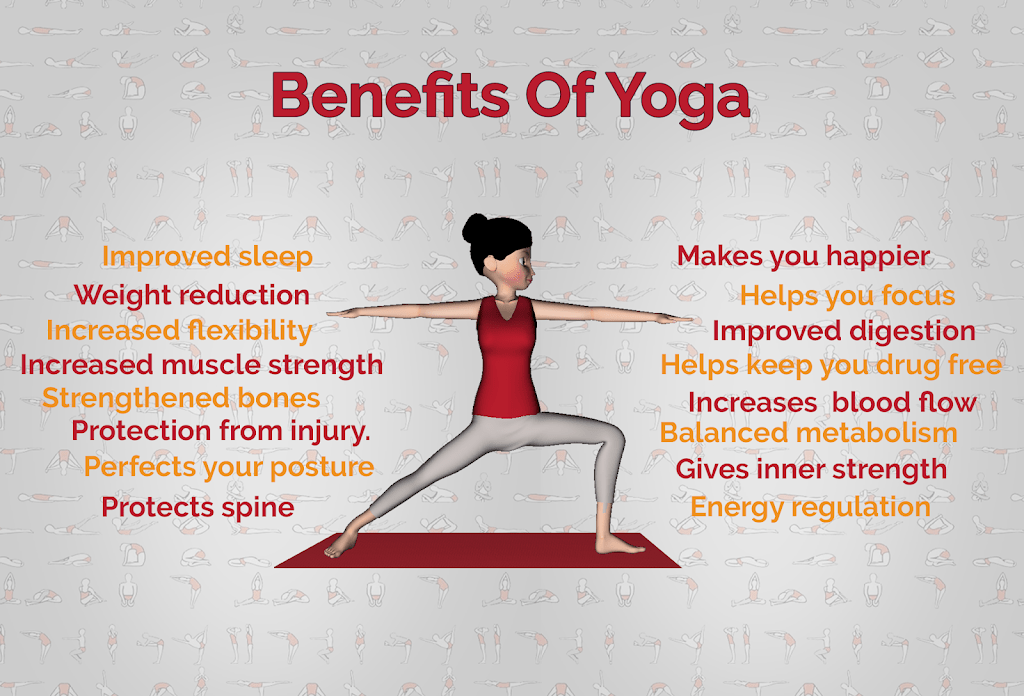16 Awesome Benefits of Yoga You Probably Didn’t Know

Before diving in, please note: This post is for informational purposes only. If you’d like to know more about how we approach topics, feel free to check out our friendly Disclaimer Page.
Hey there, amazing readers! 🖐️ Just a quick note: yes, we know there are a lot of ads here. Trust us, we get it—it’s not the prettiest look, but they help us keep this blog alive and kicking. Those pesky little ads cover the costs of all the behind-the-scenes magic, from hosting and tech stuff to creating content we hope you’ll love.
We’re committed to delivering quality posts, and your support (even just sticking around despite the ads) means everything to us. So, bear with us, and thanks for helping us keep the good vibes rolling. Now, on to the fun stuff! 😉
TRANSLATE BUTTON AT THE END OF THE ARTICLE
What Exactly is Yoga?
In its most basic form, what is yoga?
Is it simply another kind of exercise?
Is it a way of life, a set of beliefs, or a political ideology?
Or might it be something quite different?
The term “union” is what the word “Yoga” truly implies.
In this post, Sadhguru provides the following definition of yoga: “that which gets you to reality.” The core meaning of yoga
When we utter the word “yoga,” the majority of people undoubtedly picture themselves contorting their bodies into poses that are physically impossible.
Unfortunately, asanas are being promoted as if they represent the whole of yoga, despite the fact that they are only a preliminary step.
To be in complete harmony is the goal of yoga.
Your physical self, mental self, spiritual self, and the universe itself are all in perfect harmony.
In its most basic sense, the term “Yoga” may be translated as “something that takes you to reality.” It may also be translated as “unity.” When you reach union, you get at the ultimate truth, in which the many manifestations of existence are like surface bubbles in the process of creation.
Union is the mechanism by which you may achieve this.
Both a coconut tree and a mango tree have just sprung from the same patch of ground at the same time.
The human body and the bodies of countless other organisms have both sprung from the same ground.
The world is undifferentiated in every way.
The practice of yoga involves working toward an experienced reality in which one is aware of the fundamental essence of existence, namely how it is constructed.
– Sadhguru
The next paragraphs have a more elaborative definition of the yoga practice.
A Comprehensive Introduction to the Practice, Meditation, and Sutras of Yoga for Beginners
New to yoga?
We’ve got answers for you.
With the answers to these 10 typical questions asked by newbies to yoga, you should be well on your way to developing a more in-depth practice and more attentive meditation.
1. What Exactly is Yoga?
The term “yoga” originates from the Sanskrit word “yuj,” which means to yoke or bind.
Yoga is often understood to be a way of finding self-discipline as well as “unity.” A male practitioner of yoga is referred to as a “yogi,” while a female practitioner is referred to as a “yogini.”
It is claimed that the Indian sage Patanjali compiled the teachings of yoga into a text known as the Yoga Sutra around two thousand years ago.
The Sutra is a compilation of 195 assertions that acts as a conceptual reference for the majority of yoga that is performed today.
It was written by Sage Patanjali.
In addition to this, it provides an explanation of the eight different aspects of yoga, which are known as the yamas (restraints), the niyamas (observances), the asanas (postures), the pranayamas (breathing), the pratyaharas (withdrawals of the senses), the dharanas (concentrations), the dhyanis (meditations), and the samadhis (absorption).
As we go through the practice of these eight limbs, we start by honing our conduct in the external world, and then we turn our attention within until we achieve samadhi (liberation, enlightenment).
Asana, the third and final limb of yoga, is a set of physical postures that are intended to cleanse the body as well as offer the physical strength and stamina necessary for extended periods of meditation.
The majority of individuals who practice yoga today are participating in this limb.
2. What Does It Mean to be in Hatha?
Willful or forceful is the definition of the word “hatha.” The term “Hatha yoga” refers to a group of physical exercises that are also called “asanas” or “postures.” Hatha yoga also refers to sequences of asanas that are intended to align your skin, muscles, and bones.
The postures are also intended to open the various channels of the body, particularly the spine, which is considered to be the primary channel, in order to facilitate the free passage of energy.
The word “hatha” may alternatively be rendered as “ha,” which means “sun,” and “tha,” which means “moon.”
This is a reference to the harmony that exists inside each and every one of us between the masculine (active) and feminine (receptive, chill) elements of our personalities.
The practice of Hatha yoga is a method for achieving equilibrium and bringing together polarities.
When it comes to our bodies, we learn to strike a healthy balance between rigidity and mobility.
In each position, we also acquire the ability to strike a balance between active participation and passive surrender.
The practice of Hatha yoga is an effective method for inside change.
It invites us to focus our awareness on the breath, which, in turn, makes it easier for us to calm the agitations that arise in the mind and become more present in the process of each passing instant.
3. What Does It Mean When You Say Om?
Om is a vibration that is typically recited at the opening and closing of yoga sessions.
It is considered to be a mantra.
There are others who believe that it is the sound of the cosmos.
What exactly does it entail?
Ancient yogis had some way of knowing that everything in the cosmos was moving, contrary to what modern scientists are telling us.
Nothing ever remains stable or unmoving.
The ancient yogis recognized the rhythmic vibration that everything in the universe creates with the sound of Om.
This vibration is caused by everything that exists and pulsates.
Although we may not always be conscious of this sound in our day-to-day lives, we can hear it in the rustling of the trees in the fall, the waves lapping on the coast, and the inside of a seashell.
Chanting Om enables us to see our experience as a mirror of the way the whole cosmos moves, including the setting sun, the rising moon, the ebb and flow of the tides, and the beating of both our hearts and the hearts of others.
When we chant Om, it takes us on a trip on this global flow.
It does this via our breath, our awareness, and our bodily energy, and we begin to perceive a larger connection that is both energizing and calming.
4. If I Want to Practice Yoga, Do I Have to Stop Eating Meat?
Ahimsa, which translates to “not doing injury to oneself or others,” is the first principle of the yoga philosophical tradition.
Some people understand this to mean they should avoid consuming any goods that come from animals.
The community of yoga practitioners has differing opinions on this topic; nonetheless, I feel that this is an individual choice that each person has to make for themselves.
If you are thinking about becoming a vegetarian, it is important to take into consideration not just your own health concerns but also the effects that your food choices will have on the others who share your home.
It is not an act of ahimsa to force someone else to become a vegetarian; taking such an aggressive stance is not consistent with the principles of ahimsa.
5. How Many Times a Week Should I Schedule My Practice Sessions?
The practice of yoga is so incredible that you will feel the positive effects of doing it even if you just do it once a week for 60 minutes.
If you are able to achieve more than that, you will undoubtedly get an increased number of rewards.
It is my recommendation that you begin by exercising twice or three times a week for an hour and a half to two hours at a time.
If you can only devote twenty minutes to each session, that is also OK.
Do what you can and try not to worry about it; don’t allow the limitations of time or the impossibility of your ambitions to get in the way.
You will probably discover that after some time passes, your urge to practice grows on its own, and you will realize that you are engaging in ever more of it.
6. How Does Yoga Differ From Other Forms of Exercise, Particularly Stretching?
Yoga, in contrast to stretching or exercise, consists of more than merely holding physical postures.
The eight-fold path described by Patanjali is an illustration of how the physical practice of yoga is just one part of yoga.
Even within the realm of physical practice, yoga is distinctive due to the fact that we relate the movement of our bodies and the fluctuations of our minds to the rhythm of our breath.
By establishing a connection between the mind, body, and breath, we are better able to focus our attention inside.
By practicing this kind of inner focus, we are able to become aware of our ingrained thought patterns without attributing meaning to them, evaluating them, or attempting to alter them in any way.
From one instant to the next, we develop a heightened awareness of our experiences.
The cultivation of awareness is what distinguishes yoga from being a job to be done or a mission to be accomplished and instead makes it a practice.
Through the practice of yoga, not only your body but also your mind will likely become much more flexible.
7. Can Yoga be Considered a Religion?
The practice of yoga is not a faith.
It is a way of thinking that is believed to have originated in India around 5,000 years ago.
Patanjali, the author of the Yoga Sutra, is considered to be the founder of classical Ashtanga yoga, also known as the eight-limbed path.
This style of yoga should not be confused with Sri K.
Pattabhi Jois’ Ashtanga yoga.
These texts serve as a guide for developing one’s spirituality and gaining control over one’s bodily and mental bodies.
Although other ideologies, such as Buddhism and Hinduism, may be found woven within yoga on occasion, it is not required to have prior knowledge of these religions or ideas in order to practice or study yoga.
When you practice yoga, you do not have to give up your own religious convictions in order to do so.
8. I’m Not Very Flexible—is it Possible For Me to do Yoga?
Yes!
You are an excellent candidate for yoga.
A lot of people are under the impression that in order to start yoga, they need to be flexible first, but this is comparable to believing that in order to take tennis classes, you need to already be able to play tennis.
Simply showing up in your current state will let you discover how much more flexible you can become with regular yoga practice.
This newly discovered agility will be accompanied by improvements in strength, coordination, and cardiovascular health, as well as an increased feeling of self-assurance in one’s physical self and general well-being.
9. What Am I Missing to Get Started?
To get started with yoga, all you truly need is your body, your mind, and a healthy dose of curiosity.
Nothing more, nothing less.
In addition to this, it is beneficial to have a set of yoga leggings or shorts as well as a t-shirt that is not too baggy.
Because you will be walking barefoot, there is no need for any specialized footwear on your part.
It is highly recommended that you bring a towel with you to class.
The majority of yoga studios will have mats and other yoga props available for you to use, but as your practice progresses, you may find that you want to get your own yoga mat.
10. If You’re Supposed to Avoid Eating for Two to Three Hours Before Class, What’s the Deal?
During a typical yoga session, participants will bend forward and backward, twist from side to side, and even flip themselves upside down.
If you haven’t digested the food you ate the day before completely, it will make its presence known in ways that aren’t very pleasant for you.
Experiment with having a light snack such as yogurt, a few almonds, or juice around half an hour to an hour before your yoga class if you have a digestive system that works quickly and are concerned that you may get hungry or have feelings of weakness throughout your practice.
There are 16 Wonderful Advantages of Yoga That Most People are Probably Unaware of:
Improved Sleep
Loss of Excess Weight
Improve your adaptability.
Enhanced Capacity of the Muscles
Increased Stiffness of the Bones
Safeguarding against the risk of harm
Improves your stance and posture.
Helps preserve the spine
Enhances your happiness.
Allows you to focus better.
Better Digestion
Aids in preventing drug use
Improves the circulation of blood
Metabolism That Is in Check
Gives inner strength
The Regulation of Energy
More Yoga Insights
Although yoga is often renowned for its ability to increase flexibility, the practice encompasses much more than just stretching out your muscles.
You have complete control over the level of difficulty that you experience when engaging in this activity.
At the same time, getting started is a breeze, and it can be adapted to work with almost any kind of schedule.
Even if you only have 10 minutes to spare, you may still receive numerous advantages from practicing yoga in that amount of time.
Yoga is practiced with the intention of enhancing both a person’s physical health and their mental sharpness.
People from all around the globe participate in yoga since it is such an efficient form of exercise.
Yoga is a practice that can be done by anybody.
Explore the wondrous potential that lies dormant inside your own body!
A regular practice of yoga has the potential to liberate all of the great healing energy that lies dormant within you.
The practice of yoga may help produce bones, tendons, muscles, ligaments, and joints that are robust and long-lasting.
You won’t have to be concerned about your body degrading as you get older anymore.
By practicing yoga, you may protect your heart, enhance your posture, keep your weight in a healthy range, enhance your circulation, alleviate chronic pain, fortify your immune system, delay the onset of symptoms of aging, improve your coordination and balance, increase your energy, and so much more.
Even your sexual life might benefit from practicing yoga.
Do you want to enhance your mood, get rid of sadness and anxiety, raise your self-esteem, improve your attention, sharpen your memory, or boost your self-confidence?
There is a suitable yoga stance for each situation.
In fact, many.
Do you find that you are unable to enjoy some hobbies because of an injury?
No worries.
When it comes to yoga, the majority of these positions are readily adaptable to fit a variety of different physical restrictions.
Obtain the most benefit possible from your yoga practice.
You may get the tremendous benefits of yoga regardless of whether you are a working professional, a busy mom, an overworked student, or anybody else for that matter.
Yoga is accessible to everyone.
It doesn’t matter whether you only have 10 minutes to spare or if you’re lucky enough to have five hours free every day; the answer is the same.
The practice of yoga is adaptable to almost any way of living.
Figure out how to get the most out of your yoga sessions.
Find a way to incorporate a tailored yoga practice into your daily life that is both doable and enjoyable.
Investigate the many options available to you in order to create the optimal setting for your consistent yoga practice.
Be sure to investigate the different yoga postures as well as their associated health advantages, and you’ll soon begin to feel fantastic.

The Enlightenment Journey is a remarkable collection of writings authored by a distinguished group of experts in the fields of spirituality, new age, and esoteric knowledge.
This anthology features a diverse assembly of well-experienced authors who bring their profound insights and credible perspectives to the forefront.
Each contributor possesses a wealth of knowledge and wisdom, making them authorities in their respective domains.
Together, they offer readers a transformative journey into the realms of spiritual growth, self-discovery, and esoteric enlightenment.
The Enlightenment Journey is a testament to the collective expertise of these luminaries, providing readers with a rich tapestry of ideas and information to illuminate their spiritual path.
Our Diverse Expertise 🌟
While our primary focus is on spirituality and esotericism, we are equally passionate about exploring a wide range of other topics and niches 🌍📚. Our experienced team is dedicated to delivering high-quality, informative content across various subjects ✨.
To ensure we provide the most accurate and valuable insights, we collaborate with trusted experts in their respective domains 🧑🏫👩🏫. This allows us to offer well-rounded perspectives and knowledge to our readers.
Our blog originally focused on spirituality and metaphysics, but we’ve since expanded to cover a wide range of niches. Don’t worry—we continue to publish a lot of articles on spirituality! Frequently visit our blog to explore our diverse content and stay tuned for more insightful reads.





